
What is this?
|
|
Wall with Torah Niche.
Origin: Syria
Period: Jewish
Medium: Tempera on Plaster
Additional info: From inside a synagogue built within a private home. Scenes from Jewish history cover the walls. The story of Moses unfolds in a continuous narrative around the room, employing the Roman tradition of epic historical representation. The frontal poses, strong outlines, and flat colors are pictorial devices associated with Near Eastern Art.
|
| |

What is this?
|
|
Good Shepherd.
Origin: Turkey
Period: Early Christian
Medium: Marble
Additional info: Was found with sculptures portraying the life of Jonah, so likely commissioned by a Christian.
|
| |
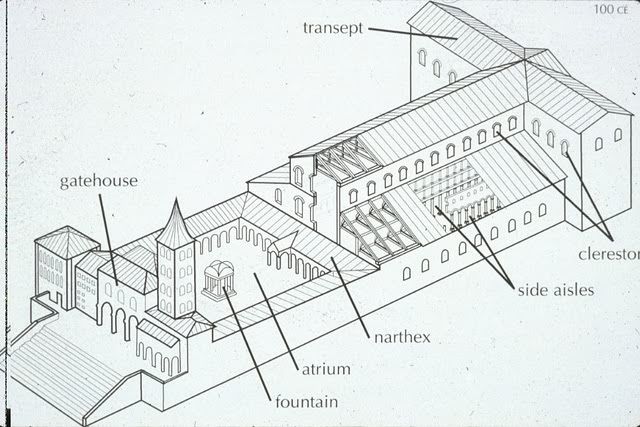
Memorize these parts.
|
|

Reconstruction of the old St. Peter's Basilica.
Origin: Rome
Period: Early Christian
Additional info: Project undertaken by Constantine, thought to be for his mother. Timber building, eventually delapidated / torn down. Could accomodate 11,000 people.
*I THINK WE CAN ASSUME THE ELEMENTS OF ARCHITECTURE WILL BE ON THE EXAM*
|
| |
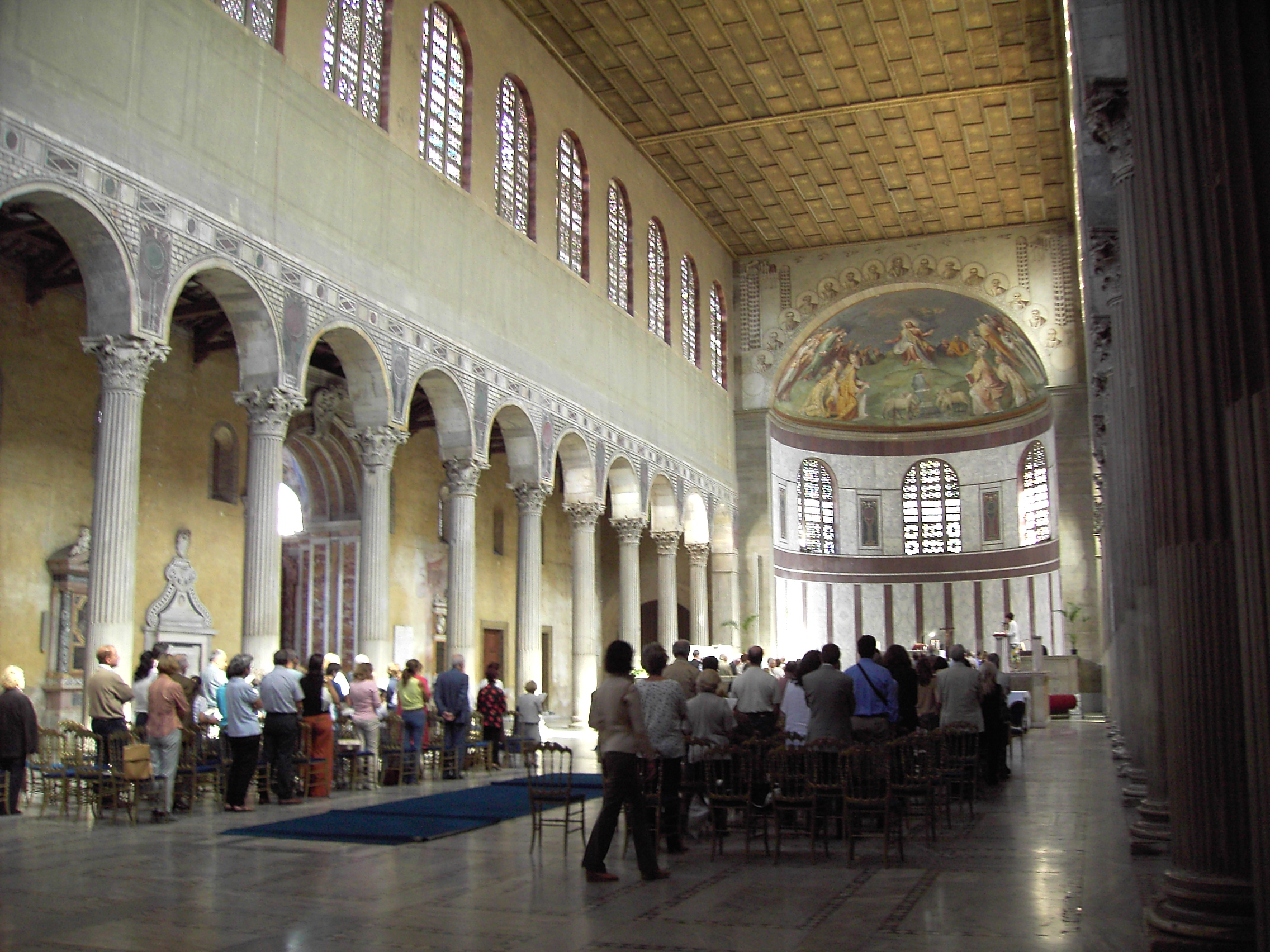
What is this?
|
|
Santa Sabina.
Origin: Rome
Period: Early Christian
Additional info: Built in brick and unusually retains its windows. On many other churches they were bricked in. Outside is plain, the inside is more impressive. Interior constructed by Peter of Illyria. Basic elements of basilica church are visible: nave lit by clerestory, side aisles that end in a rounded apse. |
| |

Memorize these parts.
|
|

Central Plan Churches.
*KNOW THESE DIAGRAMS* (p. 174)
|
| |

Memorize these parts.
|
|

Basilica Plan Churches.
*KNOW THESE DIAGRAMS* (p. 174)
|
| |
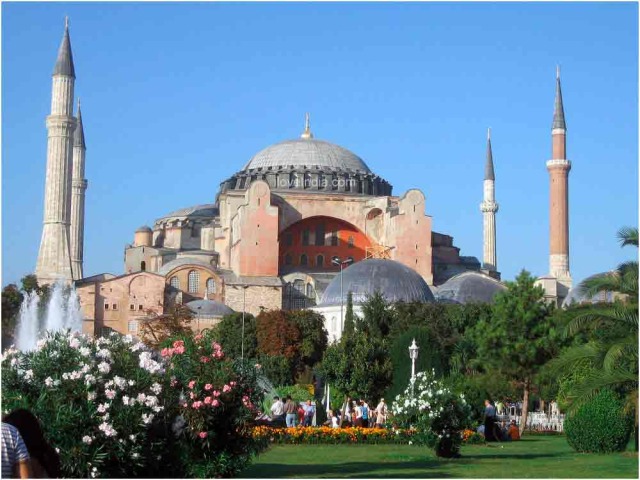
What is this?
|
|

Hagia Sophia.
Origin: Constantinople
Period: Byzantine
Patron: Justinian
Additional info: Designed by Anthemius of Tralles and Isidorus of Miletus. Anthemius was a specialist in geometry and optics and Isidorus was a specialist in physics who had studied vaulted construction. Innovative hybrid of longitudinal and central planning. Dominated by hovering form of its gigantic dome. Dome rests on pendentives (triangular curving wall sections) that connect base to supporting piers.
|
| |

What is this?
|
|
San Vitale.
Origin: Ravenna
Period: Byzantine
Patron: Ecclesius, local Bishop, but completed only after Justinian's conquest of Ravenna.
Additional info: Built by Justinian. Reclaiming lost territories from Barbarians, though he was never actually present. Dedicated to Saint Vitalis. Its design is basically a dome-covered octagon surrounded by eight excedrae, or semi-circular niches, one of which is extended through the aisle to form the santuary.
|
| |

What is this?
|
|
Justinian and attendants.
Origin: Ravenna
Period: Byzantine
Patron: Ecclesius, local Bishop, but completed only after Justinian's conquest of Ravenna.
Additional info: Justinian's head surrounded by halo, wearing huge jeweled crown and purple cloak. Carries a large golden paten that he is donating to San Vitale. Bishop Maximianus (head of Church in the West) at his left holding a jeweled cross. 6 clergymen. 6 soldiers. 12 apostles. Spiritual hierarchy.
|
| |

What is this?
|
|
Virgin and Child with Saints and Angels.
Origin: Egypt
Period: Byzantine
Additional info: Important function not only as an educational tool, but also in the removal of earthly distractions from the viewer's mind. Instruction about hierarchy within Church- Theodore and George on the sides, flat gold plates behind heads indicate holiness. Angels at the top staring at heavens. Hand of God. Mary's blue robe = mourning (foreshadowing). Mary and Christ look to the side. Man does not go to God directly, but through the Church. Saints are legendary figures said to have slain dragons, symbolically triumph over Paganism.
Rare because of iconoclasm.
|
| |
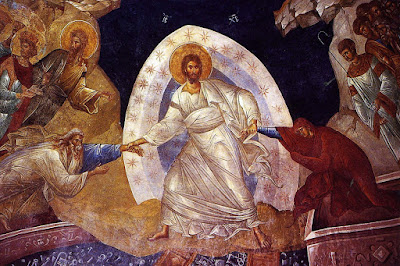
What is this?
|
|
Anastasis.
Origin: Istanbul, The Church of the Monastery of Christ in Chora
Period: Byzantine
Patron: Theodore Metochites
Additional info: Portrays the ressurection of Christ. In the East, this was done by showing Him descending into Hell to rescue Adam and Eve and others among his devout Jewish ancestors from Satan's grip. Here, He is dressed in shimmering white silk, lunging forward. Star studded mandorla or almond shaped body halo. He has trampled down the doors of Hell, tied Satan into a helpless bundle, and shattered Hell's locks and chains which are scattered all over he ground. Dragging elderly Adam and Eve from their sarcophagi. |
| |

What is this?
|
|
Chi Rho Lota Page, Book of Kells.
Origin: Scotland
Period: Hiberno-Saxon
Medium: Oxgall inks and pigments on vellum
Additional info: Very expensive to produce, est. 150 calves slaughtered for this book. Manuscripts were done in monasteries in a scriptorium. It was the work of God copying the word of God. Often developed abbreviations, made a lot of mistakes resulting in incorrect copies sent off as templates.
The large Greek letters (chi ro lota or XPI) abbreviate Christi, starting the phrase "Christi autem generatio" Ingeneratio - the beginning of the New Testament - Book of Matthew. Cat and mice represent strife of the world, a necessity for the coming of Christ.
|
| |

What is this?
|
|
Palace Chapel of Charlemagne (Palatine Chapel).
Origin: Germany
Period: Carolingian
Additional info: Charlemagne's private chapel, for his family and where his court would gather. After his death, it was his mausoleum. Draws specifically on San Vitale, but has a much darker and heavy effect. Introduction of westwork, or monumental entrance block.
|
| |

What is this?
|
|
Matthew the Evangelist, Ebbo Gospels.
Origin: France
Period: Carolingian
Patron: Archbishop Ebbo of Reims
Medium: Ink and colours on vellum.
Additional info: Depicted like an average individual, not really a naturalistic landscape. Byzantine reverse perspective. Odd, spindly hands at unusual angle. Abstraction of proportions. Emotional response due to robes, disheveled hair, worried brows, consumed by work. Erratic emotion and agitation. Charged with energy.
|
| |

What is this?
|
|
Crucifixion with Angels, Lindau Gospels Cover.
Origin: Germany
Period: Carolingian
Patron: Emperor Charles the Bald.
Medium: Gold, pearls, sapphires, garnets, emeralds.
Additional info: Combines jewels and pearls with sculpture in gold. The Crucifixion formed from the gold background using repoussé. The jewels are raised on tiny feet to allow light to penetrate under them, enhancing their luster.
|
| |

What is this?
|
|
Gero Crucifix.
Origin: Germany
Period: Ottonian
Patron: Archbishop Gero of Cologne
Medium: Painted and gilded oak
Additional info: One of the few large worked of carved wood to survive from this period. Over life size, and the focus, following Byzantine models, is on Jesus' suffering. He is shown as a tortured martyr, not as the triumphant hero of the Lindau Gospels cover. His broken, dead body sags on the cross, head fallen forward, eyes closed. Drawn face, emaciated arms and legs, sagging torso, limp bloodied hands. Meant to inspire pity and awe in the empathetic response of its viewers.
|
| |

What is this?
|
|
Bishop Bernward Doors
Origin: Germany
Period: Ottonian
Patron: Bishop Bernward of Hildesheim
Medium: Bronze
Additional info: Each door was cast as a single piece, unheard of at the time because of their size (17 feet high). 8 stories on each side (16 panels). Left = old testament, fall from grace and separation of God and mankind. Right (start at bottom) = new testament. Ends at Christ's resurrection. Can also be read side by side, for example: first murder -> first hope, expulsion from Eden -> Christ taken to temple (man's return to grace). Parallels between Mary and Eve, Cane and Abel and Christ, etc. Didatic (educational) function. Theatrical, emotional response. Varying degrees of relief. |
| |
What is this?
|
|
Cathedral of St. James (Santiago de Compostela)
Origin: Spain
Period: Romanesque
Additional info: Believed to be where St. James the Greater was buried. Built to house relics associated with him. Becomes (and remains) one of the most important pilgrimage destinations with Europe because of close connection to Christ. Design is guided by two concerns: the need to house relics in impressive shrines and to accommodate large numbers of pilgrims. Severe, grand, fortress-like because of load-bearing walls.
|
| |
.JPG)
What is this?
|
|
Creation and Fall of Adam and Eve
Origin: Italy, Modena Cathedral
Period: Romanesque
Additional info: Pervaded by the spirit of Ancient Rome. Horizontal bands of relief on the west facade are among the earliest narrative portal sculpture in Italy. Subjects taken from the book of Genesis, focusing on events from the Creation to the Flood. On the left, Father and Son framed by a mandorla supported by two angels. Three scenes from left to right: God creating Adam, bringing Eve from Adam's side, and finally covering themselves in shame as they greedily eat from the Forbidden Tree. Low relief figures with strong dimensionality. Stage like spatial setting. Would've originally been coloured with bright paint.
|
| |
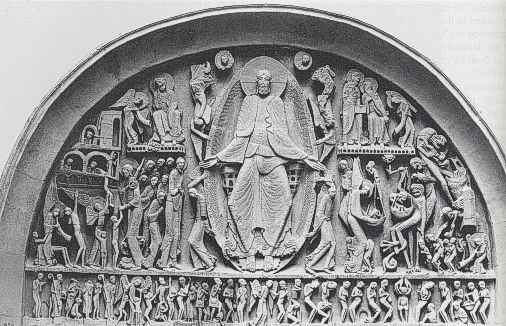
What is this?
|
|
Last Judgement, St. Lazare
Origin: France
Period: Romanesque
Additional info: A monumental Christ, enclosed in a mandorla held by two svelte angels, presides in judgment over the cowering, naked figures of the resurrected humans at his feet. The damned writhe in torment on Christ's left, while the saved reach toward an architectural vision on the other side. Viewer is reminded of the consequences of not leading a good Christian life. The church was dedicated to St. Lazarus. Gislebertus: sculptor or financier?
|
| |
|
What is this? |
|
Bishop Odo Blessing the Feast, Bayeux Tapestry
Origin: England
Period: Norman
Medium: Linen with wool
Additional info: Really an embroidery, not a tapestry. William and his brothers Odo and Robert feasting with the Norman troops before battle. Bishop Odo, seated in center, blesses the meal while others eat. May have been drawn by Norman participant as there is a clear Norman bias, but style suggests Anglo-Saxons who did the actual embroidery. Represents the kind of secular art that must once have been part of most royal courts. Could be rolled up and transported from residence to residence. Some speculate that it may have been the backdrop at banquets for stories sung by professional perfomers who could have received their cues from the identifying descriptions accompanying most scenes. Eventually given to Bayeux Cathedral, displayed on the feast of the relics.
|
| |
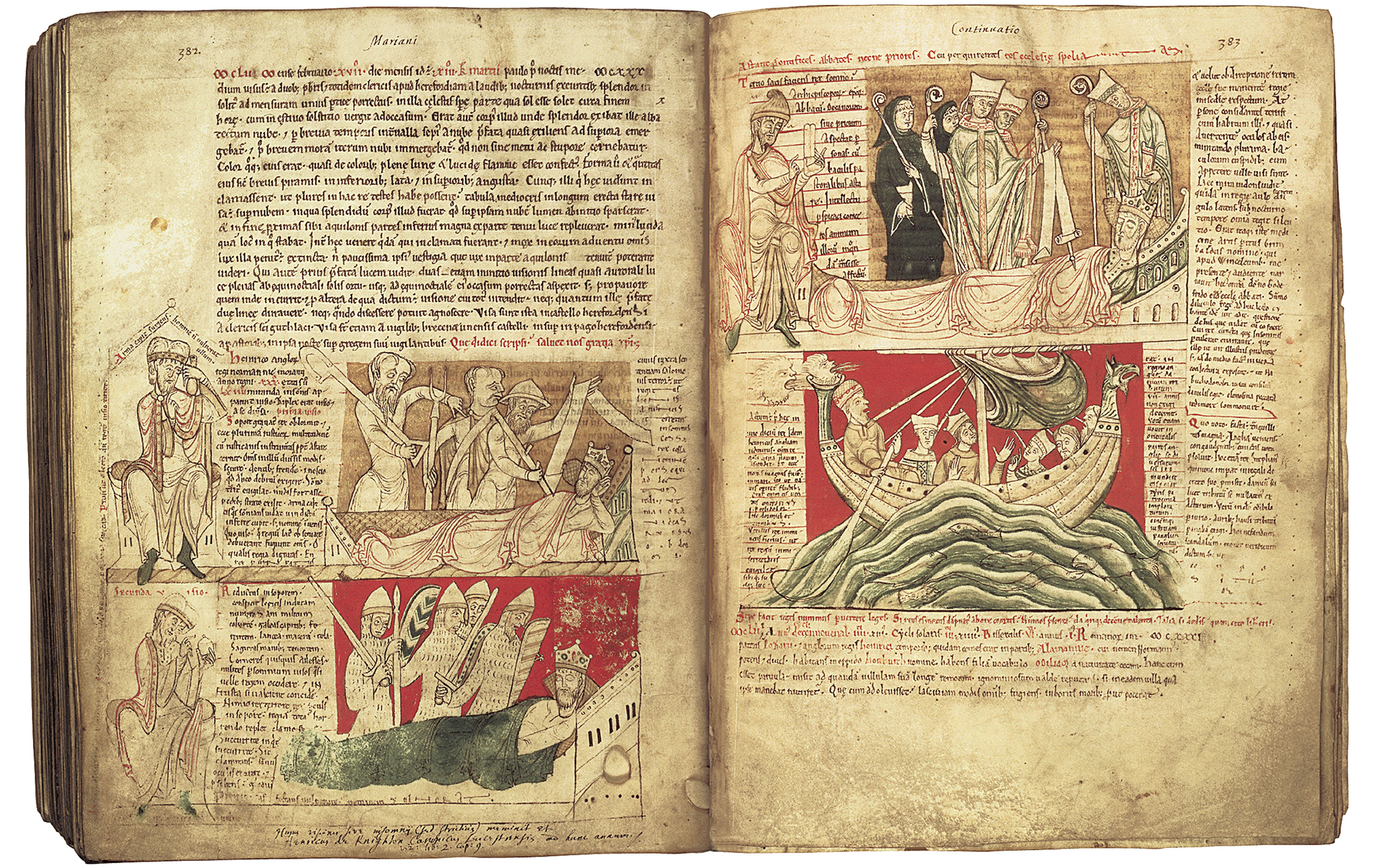
What is this? |
|
Worcester Chronicle
Origin: England
Period: Romanesque
Medium: Ink and tempera on vellum
Additional info: Earliest known illustrated history book. Written in the 12th c. by a monk named John. Concern Henry I, the second son of William the Conqueror to hold the English throne. The text relates to a series of dreams the King had in which his subjects demanded tax relief. The dreams ended with him saving his own life by making an agreement with God to rescind an increase in taxes for 7 years. Assured readers source was reliable, royal physician Grimbald who appears in margins.
|
| |

Memorize. |
|

Elements of Architecture, Romanesque Portals
|
| |
|
What is this? |
|
Ambulatory and choir, St. Denis
Origin: France
Period: Gothic
Additional info: Tall spires, stained glass windows, pointy arches, sculpture and decoration covering every inch, elaborate detail- French style. The Abbot Suger was the one behind renovating the church. A lot of the building campaigns really focus around the development of Cathedrals. A Cathedral is a seat of a Bishop. Said to house the relics of St. Denis himself. This church was also associated with the royalty- where French kings were buried. The remains of a number of monarchs rest at this Church. Pilgrimage site. In the Romanesque period they added little chapels around the apse, individual rooms. Here Suger has created an open, fluid space by removing the walls separating the chapels. Elements of gothic style: rib vault, pointed arches, stained glass, radiating chapels. None of these elements are new, but they were not previously brought together in this uniform manner. Little columns that don’t actually have a function but are decorative- compound pier. Walls don’t have to hold up the roof anymore! On the exterior walls they can take out large parts of masonry- able to include more open space, stained glass windows. To the 12th century viewer, this would seem impossible- where are the supports? Everything is light and airy.
|
| |
|
What is this? |
|
Nothing. |
| |

What is this? |
|
Royal portal, Chartres Cathedral
Origin: France
Period: Gothic
Additional info: High relief figures calmly and comfortable ill their architectural settings. Christ on central tympanum, enthroned in majesty returning at the end of time. To the right, scenes from infancy representing Incarnation. On the left, Ascension. Flanking the three doorway openings are erect, frontal statue columns, metriculous, idealized, serene. Kings and Queens presumably representing Christ's royal ancestry in the Hebrew Bible- where it got its name.
|
| |

What is this? |
|
Nave, Chartres Cathedral
Origin: France
Period: Gothic
Additional info: Pointed arches and ribbed groin vaults rising from compound piers over rectangular bays, supported by exterior flying buttresses. This system permitted masons to reserve huge openings for stained glass windows in the clerestory wall and to reduce the triforium to a mid-level passageway with an arcaded screen rather than a flat wall. Elegant glass and masonry shell encloses an enormous open space with vaults rising 120 ft above the floor.
|
| |

What is this? |
|
Annunciation and Visitation, Reims Cathedral
Origin: France
Period: Gothic
Additional info: The pair on the right portrays the Visitation, Mary pregnant with Jesus visits her cousin Elizabeth who is pregnant with Saint John the Baptist. Sculptor drew heavily on ancient sources, bulky bodies, full faces, wavy hair, heavy mantles. Contrapposto pose. The pair to the left is the Annunciation where Gabriel tells Mary she is going to birth Jesus. Mary's slight body, restrained gesture, inward focus, and delicate feature are a huge contrast to the other Mary. Different sculpture. Gabriel is by yet another sculptor.
|
| |

What is this? |
|
Sainte-Chapelle
Origin: France
Period: Gothic
Patron: Louis IX
Additional info: Constructed to house Louis IX's prized collection of relics. Pushes stained glass to the limit, almost no sense of stone walls.Extensive narrative cycles along straight walls, four lancet windows. Exploits of the Kings and Queens of Judah who Louis IX proclaimed his ancestors. The style seen here is sometimes called Court Style because of the association with the Parisian court of Louis IX was one reason it spread to courts of other European rulers.
|
| |
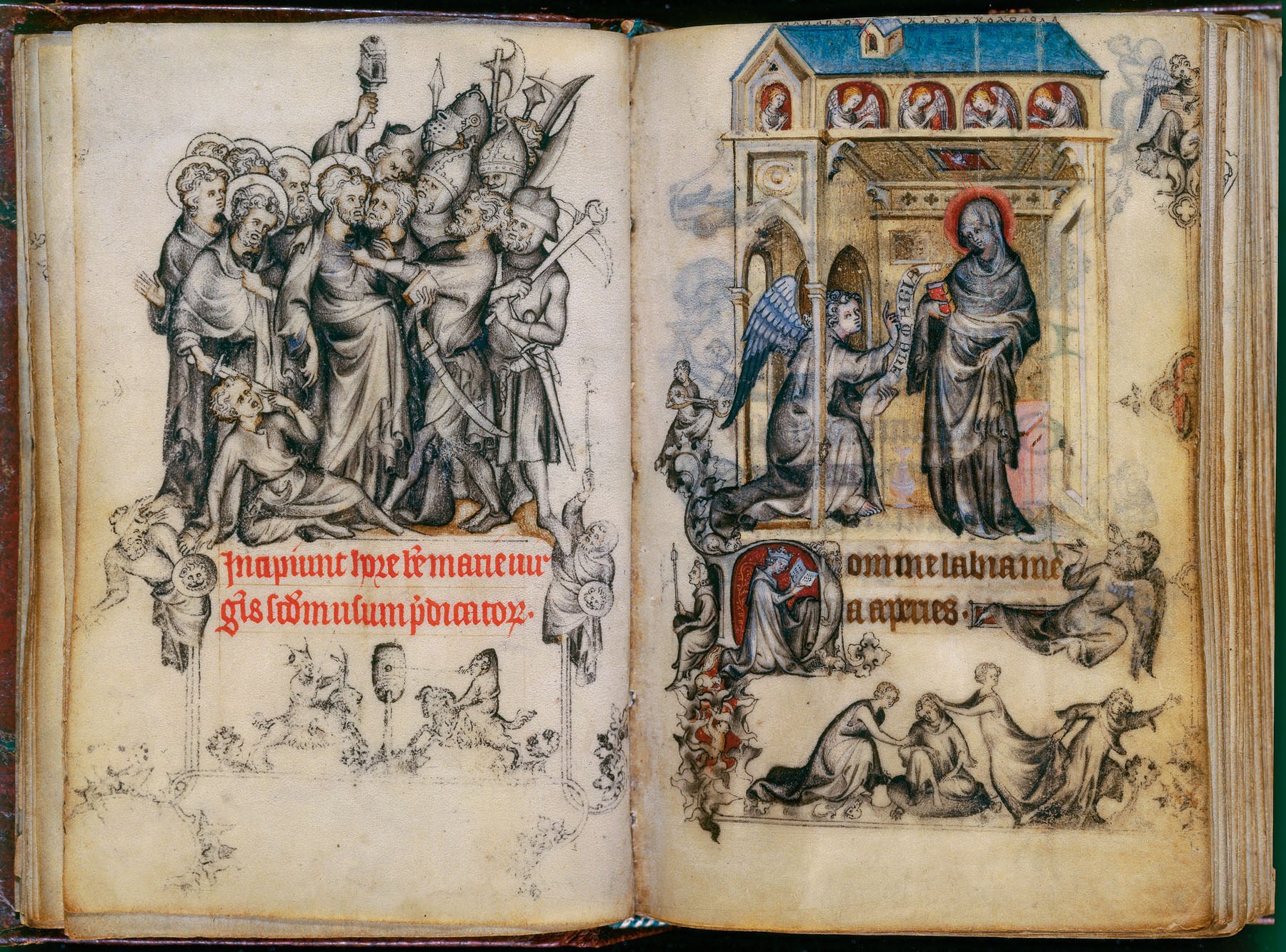
What is this? |
|
Hours of Jeanne d'Evreux
Artist: Jean Pucelle
Origin: France
Period: Gothic
Medium: Grisaille and colour on vellum
Patron: King Charles IV of France
Additional info: Given to his wife around the time of their marriage. Abandonment of intense colours used by earlier illuminators, used grisaille (only shades of grey) with delicate touches of colour. Annunciation on the right, elegantly swaying Mary receives Gabriel in her Gothic-style home which seems to project outward from the page. Queen appears herself in the letter "D", reading from her book. Pictures were personal visions inspired by meditation. On the left, Judas Iscariot embraces Jesus, identifying him to soldiers who move in to seize him. Spoof of military training below, perhaps alluding to the lack of valor by the soldiers.
|
| |
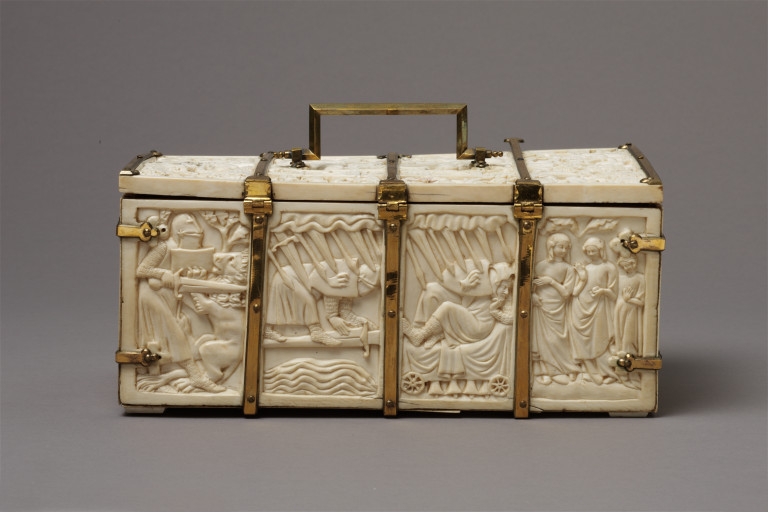
What is this? |
|
Attack on the Castle of Love
Origin: France
Period: Gothic
Medium: Ivory panel
Additional info: Tournament taking place in front of castle walls. Mock battles were originally training exercises, but came to be popular sporting events among aristocracy. In fact, military ideal gave way to new ideal of romantic love in art. On the left, ardent knights assault the Castle of Love, firing roses from crossbows and the deadly trebuchet, while women pelt the men with roses. The god of love joins in and aims his arrows at the attackers. Allegorical battle of love. Action concludes on the right where tournament's victor and his lady love meet in playful joust of their own, while others engage in flirtations.
|
| |

What is this? |
|
Allegory of Good Government
Artist: Ambrogio Lorenzetti
Origin: Italy
Period: Gothic
Medium: Fresco
Patron: Siena City Council
Additional info: This is their legislative office. Room of Peace, where officials would meet to discover matters of State. A reminder of their responsibility, the importance of a Republican government. They had overcome tyranny. The dangers and the risks of power. Council of good government on one wall, and effects of bad government on the other. Sense of volume and spacial depth. The perspective of the architecture is a little strange. Well organized, well behaved citizens. Also a representation of good government in the country. First panoramic landscape since Roman times.
|
| |
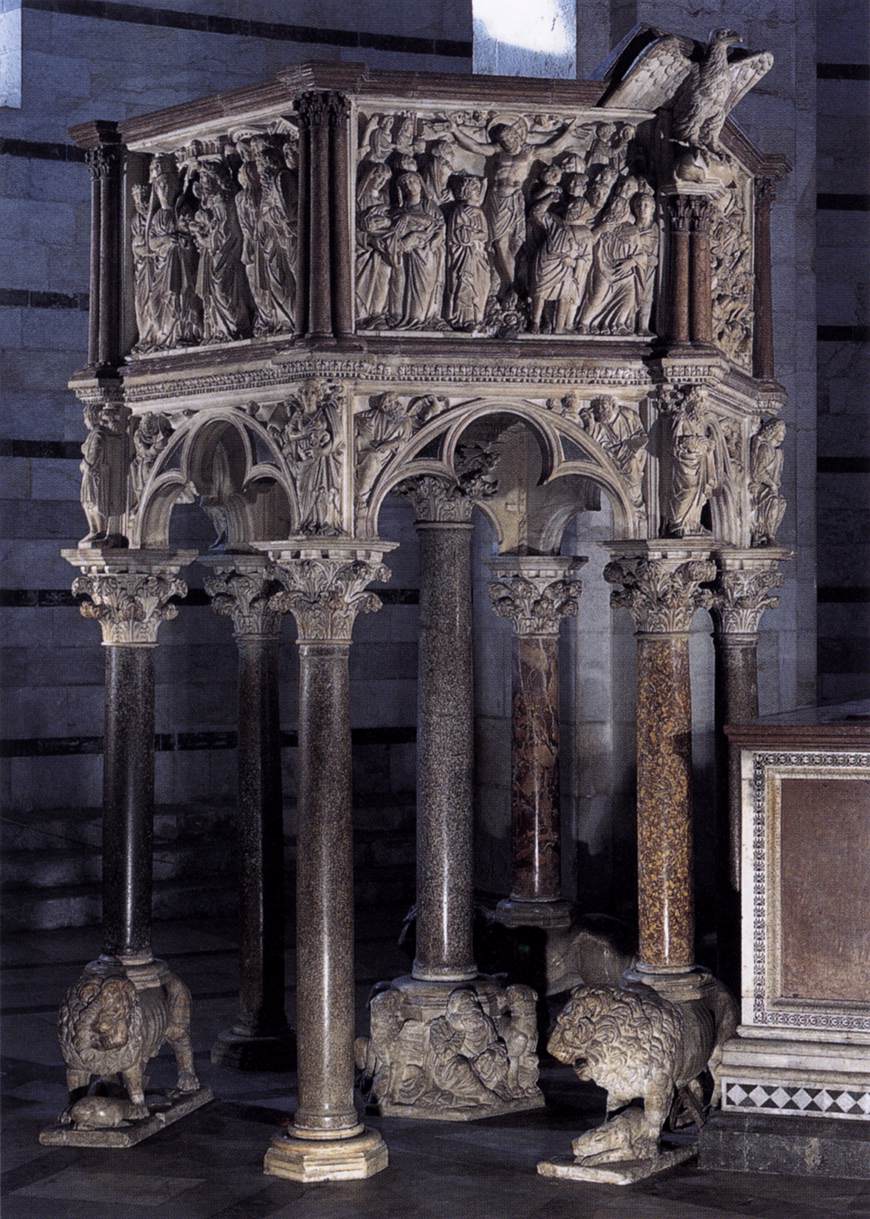
What is this? |
|
Pulpit, Baptistery, Cathedral of Pisa
Artist: Nicola Pisano
Origin: Italy
Period: Gothic
Medium: Marble
Additional info: Throwback to classical sculpture. 6-sided structure, open on one side for a stairway, supported by columns topped with leafy Corinthian capitals. Standing figures and an angel flank Gothic trefoil arches. Three columns rest on the backs of shaggy lions, guarding their prey, and the center column stands on crouching humans. Rectangular panels illustrate New Testament subjects. Deeply cut, full bodied forms almost roman, as are the heavy placid faces. The congested layout and use of hierarchical scale are less so.
|
| |

What is this? |
|
Virgin and Child Enthroned
Artist: Cimabue
Origin: Italy
Period: Gothic
Medium: Tempera and gold on wood
Additional info: Significant: name of the artist is known, has a reputation. Develops name for himself and attaches his name to his work. People recognize and seek out his work. One of the most gloried artists of the 13th century. -Final flourishing of the Byzantine style in Italy. Gold everywhere, strong sense of symmetry. At the bottom, prophets holding scrolls. Old Testament is a physical support to the New Testament. Colouring of the Madonna- darker done, typical of Byzantine tradition. Christ child looks like a shrunken adult, representation of his wisdom. Very unusual throne. Not so much Byzantine as it is Italian- looks like typical Italian architecture. Florence Bapistery & Campanile. Less of a chair than it is a building- symbolizes the Kingdom of Heaven. What’s wrong with it? Perspective is unusual, hard to determine what the relationship is between different elements.
|
| |

What is this? |
|
Arena Chapel
Artist: Giotto di Bondone
Origin: Italy
Period: Gothic
Medium: Buon fresco
Patron: Enrico Scrovegni
Additional info: Said that Cimabue was upset that he found this talent because Giotto outshone him so greatly. Giotto’s reputation very quickly spread, many people adopted his style. “Translated painting from Greek into Latin”- Byzantine dark, backwards kind of style and made it more Italian, brought in classical elements, made it more real. Enrico’s father had a horrible reputation as a user, he is featured in Dante’s Inferno. The family’s fortune was made in this way, and Enrico was not proud of it. This Chapel is a mark of atonement, dedicated to the Virgin of Charity. The panels are all about the life of the virgin.
|
| |
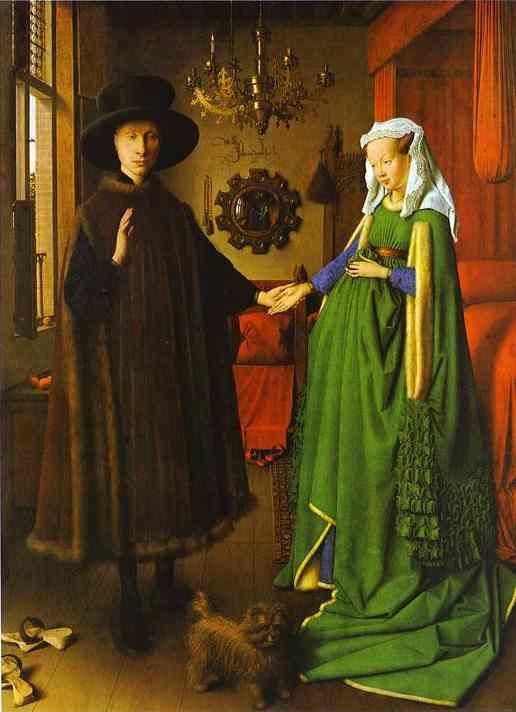
What is this? |
|
Giovanni Arnolfini and his wife Giovanna Cenami
Artist: Jan van Eyck
Origin: Netherlands
Period: Renaissance
Medium: Oil on wood panel
Patron: Giovanni Arnolfini
Additional info: van Eyck was a wonderful artist and received a great deal of notoriety and recognition. In this painting it is thought he is serving both the function of political diplomat as well as artist. No one is entirely sure what or who it exactly represents. Generally thought to be Arnolfini and his wife Giovanna Cenami. They were not married until after this was painted however. Shows a typical Flemish interior. Thought to be a receiving room. A bed on the right side. Not unusual for a Flemish home, especially for a woman who has just had a child. She is not pregnant yet, but her outfit gives the impression of pregnancy. Just a fashion statement. Could be a symbol of hope for fertility and pregnancy. The colour green represents hope. Sacred meaning- crystal prayer beads, images from Christ's Passion around mirror, figure of Saint Margaret, dog=fidelity.
|
| |

What is this? |
|
February, Tres Riches Heures
Artist: Paul, Herman and Jean Limbourg
Origin: Netherlands
Period: Renaissance
Medium: Colours and ink on parchment
Patron: Duke John of Berry
Additional info: Contrast between the life of the Duke and the life of his serfs. Some gothic treatments with flattened figures and abstraction. Beautiful luxurious rich life. In contrast, the life of the peasants. This gives him justification. He was chosen by God to have this life, it was his right. Two different kinds of serfs are shown. Industrious peasant who understood his place and was the backbone of society. Worked, labored, did not complain. Lazy, idle peasants. Drollery in the main content of the illustrations. More prone to being influenced by the Devil. Their silliness is shown through their spread legs, vulgar and crude. Immodesty. Ridiculousness of the peasants.
|
| |

What is this? |
|
Merode Altarpiece
Artist: Robert Campin
Origin: Flanderes
Period: Renaissance
Medium: Oil on wood panel
Additional info: Considered one of the first Flemish panel painters. Want the minute detail, references to the contemporary world because it makes it more relevant to their own lives. Same kind of illustrations in a larger painting. Donor painting, person who commissioned the work is depicted on the left. Speculated that his wife was added later once he was married. Three panels, that makes this a triptych. Secular life on the left wing. Surrogate for Pilgrimage. Demonstrate piety and devotion through religious panel. Doorway separates them from the sacred figures. Do not occupy equal footing, hierarchy is maintained through different panels and different spaces. Vision inspired by their piety. Annunciation is in a contemporary setting. Flemish prefer to have their own here and now. Artist does take some liberties for symbolic purposes. Lilies on the table represent the purity of Mary. She is seated, unaware. Has not yet encountered Gabriel’s announcement. Just before. Joseph: He is a carpenter, some people think he is making a wine press- reference to the Eucharist. Mouse trap on the windowsill. Outside the window is a contemporary Flemish city street scene. Mouse trap is a reference to dangers of modern life, prosperity of merchant based society. Christ is the mouse trap that will triumph over evil. Those individuals must be careful and vigilant that they do not fall into that trap.
|
| |

What is this? |
|
Goldsmith in his Shop
Artist: Petrus Christus
Origin: Netherlands
Period: Renaissance
Medium: Oil on oak panel
Additional info: Elaborate detail throughout. Saint Eloy thought to be depicted was a bishop, sainted much later. He performed Christian marriages contrary to religious practice in his region. Importance of purity in marriage. Young contemporary couple purchasing wedding jewelry, in wedding garb. Coral, pearls, teeth = security, good foundation. Moral message in little mirror in corner, outside world. Memento mori- live a good Christian life. Wealthy people carry a falcon- luxury and indulgence, forgotten responsibility. Distinction between sacred and profane.
|
| |

What is this? |
|
The Unicorn is Found
Origin: France
Period: Renaissance
Medium: Wool, silk and metal threads
Additional info: Might have been made for Anne of Brittany, whose initials (AE) appear hanging on a cord from the fountain as well as in the four corners of the composition. The unicorn could only be captured by a young virgin to whom it came willingly. The animal symbolized the Incarnation, with Christ as the unicorn captured by the Virgin Mary. In the secular world, the unicorn hunt was a metaphor for romantic love and a suitable subject for wedding tapestries.
|
| |

What is this? |
|
Buxheim St. Christopher
Origin: Germany
Period: Renaissance
Medium: Hand coloured wood cut
Additional info: Thought to be one of the earliest wood cuts. Image is carved into a block of wood and rolled with ink, pressed into a piece of paper. Paper mills develop throughout Europe in the 13th century. Paper becomes much much cheaper to produce, much more accessible to the masses. St. Christopher, Christ on his shoulders. Symbol of safe travel. Bearer of the image is granted safety and guidance. Medieval traditions: flat patterning, outlining of the figure. The proportions of the figures in relation to the background is very off. Drawing on the manuscript tradition where the spacial relationships are not so significant. Monk on the side, tiny church, tiny man on a donkey. Contemporary life and the contemporary world represented. Introductions of 15th century life into the context of religious imagery.
|
| |

What is this? |
|
San Lorenzo
Artist: Filippo Brunelleschi
Origin: Italy
Period: Renaissance
Patron: The Medici Family
Additional info: Brunelleschi was an architect and was very influential. Leaving behind all of that busy, stripy, decorative style as seen in the Florence Baptistery & Campanile. Draws on gothic theories- there should be a harmony between parts of an architectural structure. Demonstration and reflection of faith. Architecture is a rational framework that should illuminate our understanding of god. Though instead of the mysticism, he makes it very simple. He goes back to Roman architecture and draws on the style of that. Flat copper roof, triumphal arch, return to nave arcade with round arches rather than pointed, Corinthian capitals, single side isle with a very simple vaulting system over top. Repetition and simplicity with columns. Clarity in composition. White plaster accented by grey stone. One of the first architects to create blueprints and to-scale models, copious descriptions and notes for the masons.
|
| |

What is this? |
|
David
Artist: Donatello
Origin: Italy
Period: Renaissance
Medium: Bronze
Patron: The Medici Family
Additional info: Very different from previous representations: nude, flamboyant hat, hair curled and draped over shoulders, fancy boots. According to some traditions David went to fight Goliath naked- wore nothing but the protection from God. And the hat- a contemporary 15th century hat. Typical of what young men would wear. Boots are also contemporary. Holds the sword of Goliath, contrapposto stance. Head of Goliath down below. Standing on a wreath. Goliath’s helmet has wings. Idealization of the body. Unusual- the way he has represented the contrapposto. There is something effeminate, sensual and erotic about it. A little bit of a smirk, a hint of satisfaction on his face. Coyness. From the side we can see the hair of Goliath curling up around the toes, almost like David is playing with it. Wing is creeping up the inner thigh. Quite a round bum. A lot of theories about what this actually means and why Donatello was so overtly erotic in the representation of a Biblical figure.
|
| |

What is this? |
|
Gates of Paradise
Artist: Lorenzo Ghiberti
Origin: Italy, Baptistery of San Giovanni
Period: Renaissance
Medium: Gilded bronze
Patron: Wool Manufacturer's Guild
Additional info: Ten large, square reliefs. Use of linear perspective. Scenes from the Hebrew Bible beginning with the Creation in the upper left pnael.
|
| |

What is this? |
|
Tribute Money, Brancacci Chapel
Artist: Masaccio
Origin: Italy
Period: Renaissance
Medium: Fresco
Patron: Brancacci Family
Additional info: The cycle is about the life of St. Peter. Important at this particular time because of the inclusion of the tribute money. It was not a popular story. Continuous narrative- different moments of the same story in the same frame. Treatment of highlight and shadow. Believable movement of gold plates attached to the heads. Sense of atmospheric perspective. He masks to a certain degree the transition between foreground, middle ground and background. Foreshortening. Story is important/unusual because at this time Florence is at war with Milan. Milan is trying to expand into Florence, is very powerful. Florence appeals to the Pope for money to defend themselves. The Pope doesn’t want to pay them or get involved. This was included because St. Peter is considered to be the first Pope. Encouraging the Pope to have that same kind of Christian goodness, follow the teachings of Christ. Catasto - a tax based on one’s ability to pay. Wealthy families paid higher percentages. Intended to support their efforts against Milan. Many wealthy really objected to having to pay more. Even the most Saintly figures had to pay taxes, encouraged by Christ himself. A moral example.
|
| |
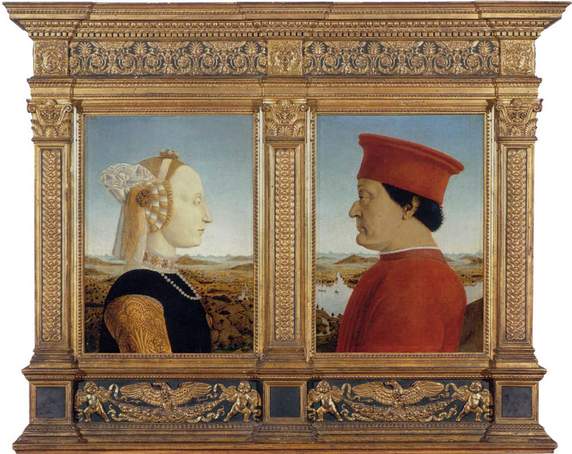
What is this? |
|
Battista Sforza and Federigo da Montelfeltro
Artist: Piero della Francesca
Origin: Italy
Period: Renaissance
Medium: Oil on wood panel
Patron: Federigo da Montefeltro
Additional info: These portraits are drawing on Roman coins- profile = aloof, elevated, superior. Federigo is very idealized. He was in his 50’s at the time and his skin is quite smooth. They are representing the soul of the sitter, a symbol of the divine origin. Her clothes are indicative of their status, he is wearing the clothes of his past as a mercenary soldier. His humble origins, showing what he worked for. Not based on an inherited position. Landscape showing the surrounding area of Urbino- the holdings of Federigo. He is elevated, sense of authority. Treatment is refined, very fine details. Very distant horizon line with atmospheric perspective.
|
| |

What is this? |
|

Camera Picta
Artist: Andrea Mantegna
Origin: Italy, Ducal Palace, Mantua
Period: Renaissance
Medium: Fresco
Patron: Ludovico Gonzaga
Additional info: One of the most important artists of the 2nd half of the 15th century. Commissioned to create a series of frescos. Intended to show different aspects of Ludovico Gonzaga’s life. Wants to create political alliances with Milan. Sforza family hires Ludovico as general of their armies. He will bring them into this room, give them a nice banquet- full of images about the awesomeness of his family. Will instill confidence in his ability to govern. Political representations of Ludovico and his sons. Landscape around the city of Mantua. Linear perspective. Messenger wearing the colours of Mantua, in service of Ludovico. Shows him in an official capacity. Surrounded by attentive family. Daily life going on to the right. A stage space, almost like watching a play. Lineage and dynasty = stability. Barbara is very stern in appearance, dressed in the latest fashion. Paola wearing similar dress, more suited for someone her age. Interesting contrast between her and her mother. Youth and beauty, virtue and quietness of Paola. She did not inherit the hunchback of her father. Advertising for a suitor. The treatment of the vaulting is antique. Flat painting lending a 3-D feel. Ornamental garlands. Oculus is revived, expert foreshortening. Cherubs hanging around on the opening. A marvel to look at. Nothing like this had been seen before, becomes a hallmark. Not really clear what exactly is represented there. The most prominent thought is that the walls down below represent the active life, the vault represents the contemplative and intellectual pursuits.
|
| |

What is this? |
|
Hercules and Antaeus
Artist: Antonio del Pollaiuolo
Origin: Italy
Period: Renaissance
Medium: Bronze
Patron: Lorenzo Medici
Additional info: Same level of detail and exaggeration. Most interested in the physical abilities of the human form. Lion skin propping him up in the back. Symmetry and dynamism through opposing vertical lines. Anteus’ leg moved up and outside illusionistic space into the viewer space. More drama. Content of emotion, concentration on Hercules’ face. Not just a prototype of a Christian knight, but also a symbol for the human condition and the Christian soul. Perfect, beautiful being that originates in God. Trapped inside material shell on Earth and forced to over come temptation and material distraction so his soul may return to God.
|
| |
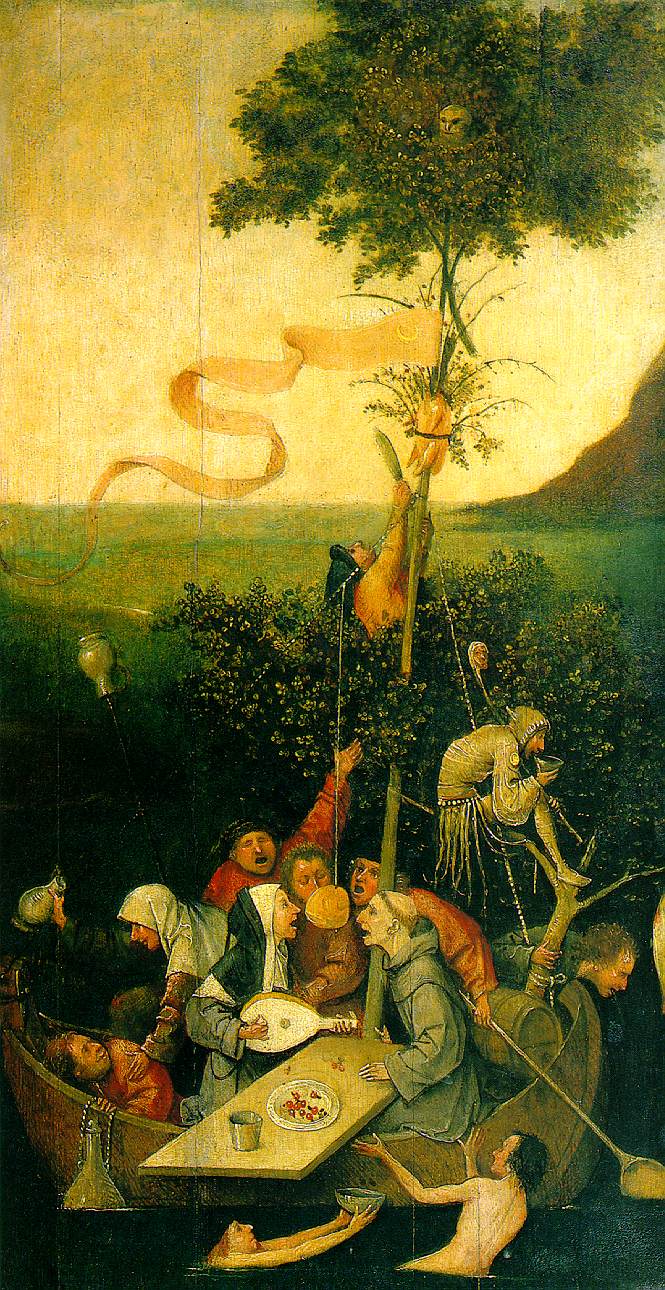
What is this? |
|
Ship of Fools
Artist: Hieronymus Bosch
Origin: Netherlands
Period: Renaissance
Medium: Oil
Additional info: Move away from strictly religious imagery. About proper behaviour of good contemporary Christians with an emphasis on satire. Beginning of carnival before Lent- indulgence. Week of celebration begins with a parade. Being a mate of the blue boat meant you were over indulgent and ridiculous. This work is an index of colloquialisms signifying greed, stupidity, illicit sex, drunkenness, etc.
|
| |

What is this? |
|
Melun Diptych
Etienne Chevalier with St. Stephen (left); Madonna & Child (right)
Artist: Jean Fouquet
Origin: France
Period: Renaissance
Medium: Oil
Patron: Etienne Chevalier
Additional info: Etienne and St. Stephen on the right- stoned to death, large rock. Patron Saint and protector. On the right, Madonna wearing contemporary French clothes. White as marble, small bow of red lips. Cherubs in red and blue, flat and monochromatic. Christ child facing Etienne- hearing his prayers. Her face is a representation of Charles VII's mistress Agnes. She was celebrated and recognized, credited for bringing the King out of lethargy. Became very influential. Saviour of France, mothering position, taking care of Charles. Colouring- red white and blue were the King's colours. Etienne is trying to win her favour, needs to be liked by her.
|
| |
|
